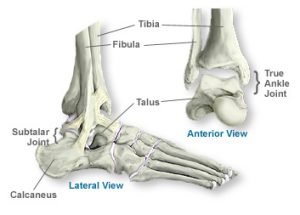Talus Fracture and Avascular Necrosis
What is the Talus?
 The talus is one of the many bones in the ankle. The lower leg bones, the tibia and fibula, attach to the Talus which rests on top of the Calcaneus, the heel, and the rest of the foot. The talus is very important structurally to allow for motion of the foot and a fracture of the talus can have quite serious consequences to the ability to use the foot properly without being corrected.
The talus is one of the many bones in the ankle. The lower leg bones, the tibia and fibula, attach to the Talus which rests on top of the Calcaneus, the heel, and the rest of the foot. The talus is very important structurally to allow for motion of the foot and a fracture of the talus can have quite serious consequences to the ability to use the foot properly without being corrected.
What causes a Talus fracture?
The Talus is a strong and very protected bone. It is rare for a Talus to fracture, but high amounts of energy that could be experienced in a fall from a great height or a car wreck will do it. A fracture of the Talus is both serious and painful. Immediately a large amount of the range of motion of the foot will be lost, and without surgical intervention many talus fractures will result in a severe limp, arthritis, and severe chronic pain.
What is the treatment for a Talus fracture?
While many Talus fractures require surgical treatment due to the high energy nature of their origin causing displacement that would be detrimental to body mechanics of the foot, some fall into the scope of non-operative treatment if they are stable and relatively non-displaced. For talus fractures that are treatable by casting the patient will be non-weight baring in a cast for 6-8 weeks, and then followed up on with physical therapy to work on recovering flexibility, strength, and range of motion.
Surgical intervention is usually necessary and will require an open reduction, to realign the nature place of the bone, and then stabilization. The stabilization will be completed with the addition of hardware, such as metal plates, and screws. After a fracture arthritis may set in and eventually require a fusion such as a subtalar fusion.
Talus fracture and Avascular Necrosis (AVN)
Unfortunately, one of the common side effects of a Talus fracture is eventual bone death of the talus from avascular necrosis (AVN). Avascular necrosis, or AVN, is a condition in which blood supply is no longer delivering sufficient oxygen to the bone. Avascular Necrosis can occur throughout many areas in the body such as the knee or hip as well. When avascular necrosis is present in the talus damage is sustained to surrounding cartilage as well. This condition is hard to treat and can result in severe arthritis, pain, and loss of stability of the ankle joint. If you fracture your talus it is important to follow up with a physician throughout the healing process so that if you have AVN set in you can be treated as soon as possible.

